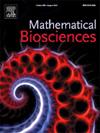纳入无症状和超级传播者个体的COVID-19传播的部分建模。
IF 1.8
4区 数学
Q2 BIOLOGY
引用次数: 0
摘要
COVID-19大流行在全球范围内带来了前所未有的挑战,需要有效的建模方法来了解和控制其传播动态。在这项研究中,我们提出了一种新的方法,将无症状和超级传播者个体整合在一个单一的室室模型中。我们强调了在常微分方程中使用非比例分数阶导数的优点,包括在捕捉疾病动力学方面增加了灵活性,并在传播过程中改进了记忆效应。我们对我们提出的模型进行定性分析,包括确定基本繁殖数和分析无病平衡的稳定性。通过将所提出的模型与葡萄牙的实际数据进行拟合,并与现有模型进行比较,我们证明了补充人口类别和分数导数的加入显著提高了模型的拟合优度。敏感性分析进一步为设计有效的策略以减轻病毒的传播提供了宝贵的见解。本文章由计算机程序翻译,如有差异,请以英文原文为准。
Fractional modelling of COVID-19 transmission incorporating asymptomatic and super-spreader individuals
The COVID-19 pandemic has presented unprecedented challenges worldwide, necessitating effective modelling approaches to understand and control its transmission dynamics. In this study, we propose a novel approach that integrates asymptomatic and super-spreader individuals in a single compartmental model. We highlight the advantages of utilizing incommensurate fractional order derivatives in ordinary differential equations, including increased flexibility in capturing disease dynamics and refined memory effects in the transmission process. We conduct a qualitative analysis of our proposed model, which involves determining the basic reproduction number and analysing the disease-free equilibrium’s stability. By fitting the proposed model with real data from Portugal and comparing it with existing models, we demonstrate that the incorporation of supplementary population classes and fractional derivatives significantly improves the model’s goodness of fit. Sensitivity analysis further provides valuable insights for designing effective strategies to mitigate the spread of the virus.
求助全文
通过发布文献求助,成功后即可免费获取论文全文。
去求助
来源期刊

Mathematical Biosciences
生物-生物学
CiteScore
7.50
自引率
2.30%
发文量
67
审稿时长
18 days
期刊介绍:
Mathematical Biosciences publishes work providing new concepts or new understanding of biological systems using mathematical models, or methodological articles likely to find application to multiple biological systems. Papers are expected to present a major research finding of broad significance for the biological sciences, or mathematical biology. Mathematical Biosciences welcomes original research articles, letters, reviews and perspectives.
 求助内容:
求助内容: 应助结果提醒方式:
应助结果提醒方式:


